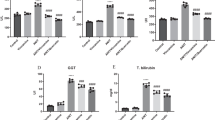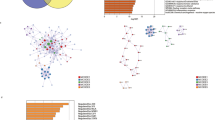Abstract
Animal bile is popularly used as a traditional medicine in China, and bile acids are their major bioactive constituents. In the present study, effects of bile extract from crocodile gallbladder on QBC939 cell growth, cell cycle, and apoptosis were investigated by MTT assay, inverted microscopy, fluorescence microscopy, transmission electron microscopy, scanning electron microscopy, PI single- and FITC/PI double-staining flow cytometry, and western blotting. Our data have revealed that bile extract inhibited cells growth significantly, and the cell cycle was arrested in G1 phase. Bile extract induced QBC939 cell apoptosis, which was associated with collapse of the mitochondrial membrane potential and increase of ROS. In bile extract-treated cells, it was observed that the expression of bcl-2 decreased and cytochrome c released to cytosol, but the expression of bax remained unchanged. The data indicated that mitochondrial pathway might play an important role in bile extract-induced apoptosis in QBC939 cells. These results provide significant insight into the anticarcinogenic action of bile extract on cholangiocarcinoma cells.




Similar content being viewed by others
Abbreviations
- CCA:
-
Cholangiocarcinoma
- ROS:
-
Reactive oxygen species
- ΔΨm:
-
Mitochondrial transmembrane potential
- PI:
-
Propidium iodide
- FBS:
-
Fetal bovine serum
- MTT:
-
3-(4,5-dimethylthiazol-2-yl)-2,5-diphenyl tetrazolium bromide
- HRP:
-
Horseradish peroxidase
- ECL:
-
Enhanced chemiluminescence
- TEM:
-
Transmission electron microscopy
- SEM:
-
Scanning electron microscope
- Rh123:
-
Rhodamine 123
- DCFH-DA:
-
2,7-Dichlorofluorescein diacetate
- DCF:
-
2,7-Dichlorofluorescein
References
Mahmoud, N. N., Dannenberg, A. J., Bilinski, R. T., Mestre, J. R., Chadburn, A., Churchill, M., et al. (1999). Administration of an unconjugated bile acid increases duodenal tumors in a murine model of familial adenomatous polyposis. Carcinogenesis, 20, 299–303. doi:10.1093/carcin/20.2.299.
Martinez, J. D., Stratagoules, E. D., LaRue, J. M., Powell, A. A., Gause, P. R., Craven, M. T., et al. (1998). Different bile acids exhibit distinct biological effects: The tumor promoter deoxycholic acid induces apoptosis and the chemopreventive agent ursodeoxycholic acid inhibits cell proliferation. Nutrition and Cancer, 31, 111–118. doi:10.1080/01635589809514689.
Tatsumura, T., Sato, H., Yamamoto, K., & Ueyama, T. (1981). Ursodeoxycholic acid prevents gastrointestinal disorders caused by anticancer drugs. The Japanese Journal of Surgery, 11, 84–89. doi:10.1007/BF02468874.
Alberts, D. S., Martinez, M. E., Hess, L. M., Einspahr, J. G., Green, S. B., Bhattacharyya, A. K., et al. (2005). Phase III trial of ursodeoxycholic acid to prevent colorectal adenoma recurrence. Journal of the National Cancer Institute, 97, 846–853. doi:10.1093/jnci/dji144.
Tint, G. S., Dayal, B., Batta, A. K., Shefer, S., Joanen, T., Larry, M., et al. (1980). Biliary bile acids, bile alcohols, and sterols of Alligator mississippiensis. Journal of Lipid Research, 21, 110–117.
Yeh, Y. H., Wang, D. Y., Liau, M. Y., Wu, M. L., Deng, J. F., Noguchia, T., et al. (2003). Bile acid composition in snake bile juice and toxicity of snake bile acids to rats. Comparative Biochemistry and Physiology, 136, 277–284. doi:10.1016/S1532-0458(03)00230-8.
Malhi, H., & Gores, G. J. (2006). Cholangiocarcinoma: Modern advances in understanding a deadly old disease. Journal of Hepatology, 45, 856–867. doi:10.1016/j.jhep.2006.09.001.
Patel, T. (2002). Worldwide trends in mortality from biliary tract malignancies. BMC Cancer, 2, 10. doi:10.1186/1471-2407-2-10.
Lazaridis, K. N., & Gores, G. J. (2005). Cholangiocarcinoma. Gastroenterology, 128, 1655–1667. doi:10.1053/j.gastro.2005.03.040.
Gatto, M., Bragazzi, M. C., Semeraro, R., Napoli, C., Gentile, R., Torrice, A., et al. (2010). Cholangiocarcinoma: Update and future perspectives. Digestive and Liver Disease, 42, 253–260. doi:10.1016/j.dld.2009.12.008.
Hu, Y., Yang, Y., You, Q. D., Liu, W., Gu, H. Y., Zhao, L., et al. (2006). Oroxylin A induced apoptosis of human hepatocellular carcinoma cell line HepG2 was involved in its antitumor activity. Biochemical and Biophysical Research Communications, 351, 521–527. doi:10.1016/j.bbrc.2006.10.064.
Han, P., Kang, J. H., Li, H. L., Hu, S. X., Lian, H. H., Qiu, P. P., et al. (2009). Antiproliferation and apoptosis induced by tamoxifen in human bile duct carcinoma QBC939 cells via upregulated p53 expression. Biochemical and Biophysical Research Communications, 385, 251–256. doi:10.1016/j.bbrc.2009.05.059.
Farnebo, M., Bykov, V. J., & Wiman, K. G. (2010). The p53 tumor suppressor: A master regulator of diverse cellular processes and therapeutic target in cancer. Biochemical and Biophysical Research Communications, 396, 85–89. doi:10.1016/j.bbrc.2010.02.152.
Mork, C. N., Faller, D. V., & Spanjaard, R. A. (2005). A mechanistic approach to anticancer therapy: Targeting the cell cycle with histone deacetylase inhibitors. Current Pharmaceutical Design, 11, 1091–1104. doi:10.2174/1381612053507567.
Tompson, C. B. (1995). Apoptosis in the pathogenesis and treatment of disease. Science, 267, 1456–1462. doi:10.1126/science.7878464.
Green, D. R. (1998). Apoptotic pathways: The roads to run. Cell, 94, 695–698.
Green, D. R., & Reed, J. C. (1998). Mitochondria and apoptosis. Science, 281, 1308–1312. doi:10.1126/science.281.5381.1309.
Zong, W. X., Li, C., Hatzivassiliou, G., Lindsten, T., Yu, Q. C., Yuan, J., et al. (2003). Bax and Bak can localize to the endoplasmic reticulum to initiate apoptosis. The Journal of Cell Biology, 162, 59–69. doi:10.1083/jcb.200302084.
Circu, M. L., & Aw, T. Y. (2010). Reactive oxygen species, cellular redox systems, and apoptosis. Free Radical Biology & Medicine, 48, 749–762. doi:10.1016/j.freeradbiomed.2009.12.022.
Sakon, S., Xue, X., Takekawa, M., Sasazuki, T., Okazaki, T., Kojima, Y., et al. (2003). NF-kappaB inhibits TNF-induced accumulation of ROS that mediate prolonged MAPK activation and necrotic cell death. The EMBO Journal, 22, 3898–3909. doi:10.1093/emboj/cdg379.
Chen, Y., & Gibson, S. B. (2008). Is mitochondrial generation of reactive oxygen species a trigger for autophagy? Autophagy, 16, 246–248.
Acknowledgments
The present investigation was supported by Grant 81072014 of the Natural Science Foundation of China, National Foundation for fostering talents of basic science (J1030626) and supported by Sriracha Tiger Zoo Co., Ltd. Sriracha Thailand.
Author information
Authors and Affiliations
Corresponding author
Additional information
Jin-He Kang and Wen-Qing Zhang contributed equally to this work.
Rights and permissions
About this article
Cite this article
Kang, JH., Zhang, WQ., Song, W. et al. Apoptosis Mechanism of Human Cholangiocarcinoma Cells Induced by Bile Extract from Crocodile. Appl Biochem Biotechnol 166, 942–951 (2012). https://doi.org/10.1007/s12010-011-9482-x
Received:
Accepted:
Published:
Issue Date:
DOI: https://doi.org/10.1007/s12010-011-9482-x




